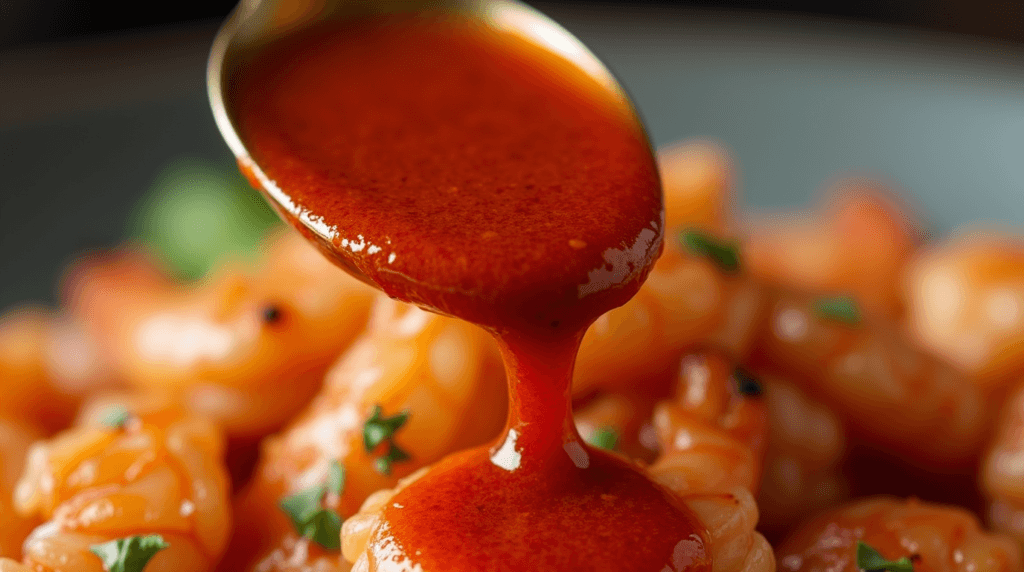Tiger Sauce has gained a reputation as a bold and versatile condiment, loved for its unique balance of sweet, tangy, and spicy flavors. Whether used as a marinade, a dipping sauce, or a finishing drizzle, Tiger Sauce adds a burst of flavor to everything from grilled meats to seafood and even vegetables.

But what is Tiger Sauce made of? What are the ingredients that create this distinctive taste? In this guide, we’ll break down the key components of Tiger Sauce, explore its origins, and understand why it has become a must-have in kitchens and restaurants worldwide.
Let’s dive into the world of Tiger Sauce and uncover the ingredients behind its irresistible flavor.
What is Tiger Sauce?
Origin and History of Tiger Sauce
Tiger Sauce was first introduced in the 1980s by TryMe Sauces, a company known for its creative and flavorful condiments. Originating in the United States, Tiger Sauce quickly became a favorite among chefs and home cooks alike due to its ability to complement a wide variety of dishes. For a deeper dive into creating your own sauces at home, check out this Kefir Sheet Cake Recipe, which provides insights into balancing flavors in sweet dishes.
How Tiger Sauce Became Popular
Tiger Sauce’s popularity soared thanks to its unique flavor profile and versatile applications. It became especially popular in Southern-style cooking and barbecue culture. Today, it’s a go-to condiment for people who love a balance of sweet heat in their dishes. For more tangy and bold sauce ideas, explore this Dubai Chocolate Recipe for an international twist.
Key Ingredients in Tiger Sauce
Tiger Sauce is known for its unique blend of sweet, tangy, and spicy flavors. While the exact recipe might vary slightly between brands, the core ingredients remain consistent.
Main Ingredients and Their Roles
| Ingredient | Role in Tiger Sauce |
|---|---|
| Cayenne Pepper | Provides the signature spicy kick. |
| Sugar or Corn Syrup | Adds sweetness to balance the heat. |
| Vinegar | Offers tanginess and preserves freshness. |
| Tomato Paste | Adds richness and depth to the sauce. |
| Worcestershire Sauce | Enhances the umami and savory notes. |
| Garlic Powder | Adds aromatic flavor and warmth. |
| Spices & Seasonings | A mix of secret spices that define the unique taste. |
For a similar sauce experience, you might enjoy experimenting with the flavors in this Vanilla Paste Recipe.
Secret Ingredient Behind the Unique Flavor
While the above ingredients are standard, many believe that the secret to Tiger Sauce’s distinctive flavor lies in its proprietary spice blend. This blend creates a harmonious balance of sweet, tangy, and spicy notes that make Tiger Sauce so memorable. For other bold and unique condiments, check out this Cheesy Garlic Chicken Wraps Recipe for pairing inspiration.
Flavor Profile of Tiger Sauce
Tiger Sauce is often described as a “sweet heat sauce” because of its unique blend of flavors.
A Blend of Sweet, Tangy, and Spicy Notes
- Sweetness: Comes from sugar or corn syrup, providing a smooth flavor.
- Tanginess: Derived from vinegar, adding brightness to the sauce.
- Spiciness: From cayenne pepper, giving it a gentle heat without being overpowering. For more creative pairing ideas, explore this Fishing Cake Ideas guide.
What Makes Tiger Sauce Unique?
The magic of Tiger Sauce lies in its versatility. It’s not overwhelmingly spicy, yet it carries enough heat to leave a lasting impression. Its balance of flavors makes it suitable for marinades, dips, and even finishing sauces. If you’re interested in unique flavor combinations, don’t miss this Purple Velvet Cake Recipe.
Nutritional Information of Tiger Sauce
Understanding the nutritional content of Tiger Sauce helps you enjoy it guilt-free while being mindful of your dietary needs. While the exact nutritional values can vary slightly by brand, here’s a general overview of what you’ll find in a standard serving of Tiger Sauce:
Nutritional Breakdown per 1 Tablespoon (15g)
| Nutrient | Amount | % Daily Value |
|---|---|---|
| Calories | 15 | 1% |
| Total Fat | 0g | 0% |
| Sodium | 200mg | 8% |
| Total Carbohydrates | 4g | 1% |
| Sugars | 3g | — |
| Protein | 0g | 0% |
For another flavorful low-calorie option, check out this Oreo Mug Cake Recipe.
Key Nutrients in Tiger Sauce
- Low-Calorie Content: Tiger Sauce is relatively low in calories, making it a guilt-free condiment option.
- High Sodium Levels: It’s important to monitor sodium intake if using Tiger Sauce in large quantities.
- Sugar Content: Adds sweetness but should be considered if you’re watching your sugar intake.
While Tiger Sauce isn’t a significant source of vitamins or minerals, its rich flavor allows you to use it sparingly while still enhancing your dishes.
How is Tiger Sauce Made?
While the exact recipe of Tiger Sauce remains a trade secret, the general production process is fairly straightforward.
Traditional Preparation Process
- Mixing Ingredients: Cayenne pepper, sugar, vinegar, tomato paste, Worcestershire sauce, and spices are combined in precise proportions.
- Cooking and Simmering: The mixture is simmered to allow the flavors to meld together.
- Cooling and Bottling: Once the sauce reaches the desired consistency, it’s cooled and bottled.
- Quality Control: Each batch undergoes taste testing to ensure flavor consistency.
Modern Commercial Production Methods
In commercial production, automated systems are used to:
- Measure and mix ingredients consistently.
- Maintain sterilized environments to ensure shelf stability.
- Bottle and seal sauces efficiently for distribution.
This balance of traditional recipes and modern technology ensures every bottle of Tiger Sauce delivers the same iconic taste.
Popular Uses for Tiger Sauce
Tiger Sauce’s unique blend of sweet, tangy, and spicy flavors makes it incredibly versatile in the kitchen. From marinades to dipping sauces, its applications are nearly endless.
Culinary Applications in Different Dishes
| Dish Type | How to Use Tiger Sauce |
|---|---|
| Grilled Meats | Use as a marinade for chicken, pork, or beef. |
| Seafood | Drizzle over shrimp, fish, or crab cakes. |
| Sandwiches | Add to burgers, wraps, or deli-style sandwiches. |
| Wings | Toss fried or baked chicken wings in Tiger Sauce. |
| Stir-Fries | Mix into stir-fried vegetables or noodles. |
| Dips & Sauces | Serve as a dipping sauce for fries or egg rolls. |
Explore a sweet-savory twist with this Dubai Chocolate Recipe.
Pairing Suggestions for Tiger Sauce
Tiger Sauce pairs beautifully with a wide range of foods. Here are some top recommendations:
- Proteins: Chicken wings, grilled shrimp, pork chops.
- Vegetables: Roasted brussels sprouts, grilled corn, stir-fried greens.
- Snacks: French fries, mozzarella sticks, spring rolls.
Its balance of flavors ensures it enhances both savory and slightly sweet dishes, making it a staple in many kitchens.
Homemade Tiger Sauce Recipe
If you love Tiger Sauce and want to try making it at home, here’s a simple DIY recipe you can follow:
Ingredients:
- 1/2 cup hot sauce (cayenne-based)
- 1/4 cup brown sugar
- 2 tablespoons Worcestershire sauce
- 1 tablespoon apple cider vinegar
- 1 tablespoon tomato paste
- 1/2 teaspoon garlic powder
- 1/4 teaspoon cayenne pepper
- Pinch of salt
Instructions:
- Combine Ingredients: Mix all ingredients in a saucepan.
- Simmer: Heat over medium-low heat for 10–15 minutes, stirring occasionally.
- Adjust Seasoning: Taste and adjust sweetness, salt, or spice as needed.
- Cool and Store: Let the sauce cool, then transfer to a clean bottle or jar.
Tips for Perfecting the Flavor:
- Add honey for extra sweetness.
- Adjust cayenne pepper for more heat.
- Store in an airtight container in the refrigerator for up to 2 weeks.
This homemade version captures the bold flavors of traditional Tiger Sauce and allows for customization based on your preferences.
Variations of Tiger Sauce
Tiger Sauce has evolved over time, with regional and brand-specific variations offering unique twists on the original recipe.
Regional Differences in Tiger Sauce Recipes
| Region | Flavor Profile | Common Ingredients |
|---|---|---|
| Southern USA | Bold and spicy with sweetness | Cayenne pepper, molasses, vinegar |
| Asian Fusion | Tangy with umami notes | Soy sauce, ginger, chili paste |
| Caribbean | Tropical heat with sweetness | Scotch bonnet peppers, pineapple |
Different regions incorporate local spices and flavors, giving their version of Tiger Sauce a distinct identity while maintaining the sauce’s signature sweet-heat balance.
Popular Brand Variations
Several brands have introduced their own interpretations of Tiger Sauce, each adding a unique flair:
- TryMe Tiger Sauce: The classic and most popular version. Balanced sweet, tangy, and spicy notes.
- Spicy Honey Tiger Sauce: A honey-infused version with a milder kick.
- Extra Hot Tiger Sauce: Designed for those who crave a bolder heat profile.
- Smoky Tiger Sauce: Infused with a smoky flavor, ideal for grilling and barbecues.
Each variation caters to different taste preferences, ensuring there’s a Tiger Sauce for everyone.
Where to Buy Tiger Sauce
Finding authentic Tiger Sauce isn’t difficult, thanks to its widespread availability both online and in local stores.
Online Retailers
- Amazon: Wide selection, including classic and specialty versions.
- Walmart: Available both in-store and online.
- Target: Often stocked in the condiments section.
Local Grocery Stores
Most large supermarket chains carry Tiger Sauce in the condiment aisle. Specialty food stores might also have unique regional variations.
How to Identify Authentic Tiger Sauce
- Look for the TryMe brand logo on the packaging.
- Check the ingredient list for key components like cayenne pepper, vinegar, and sugar.
- Avoid overly diluted or generic “spicy sauce” labels.

Whether online or in-store, Tiger Sauce remains an accessible and flavorful addition to any kitchen. For other pantry essentials, consider looking into recipes like this Vanilla Paste Recipe.
Frequently Asked Questions About Tiger Sauce
Is Tiger Sauce Very Spicy?
No, Tiger Sauce offers a mild to moderate heat level. It’s spicy enough to add a kick but balanced with sweetness and tanginess, making it enjoyable for most spice tolerance levels.
Can I Make Tiger Sauce at Home?
Yes! You can make a homemade version using ingredients like hot sauce, brown sugar, Worcestershire sauce, vinegar, and spices. The recipe can be customized based on your heat and sweetness preferences.
What Does Tiger Sauce Taste Like?
Tiger Sauce combines sweet, tangy, and spicy flavors. It’s often described as a “sweet heat sauce” with a complex taste profile that pairs well with meats, seafood, and vegetables.
Is Tiger Sauce Gluten-Free?
Most commercially produced Tiger Sauces are gluten-free, but it’s always best to check the ingredient label for any gluten-containing additives or cross-contamination warnings.
How Long Does Tiger Sauce Last After Opening?
Once opened, Tiger Sauce should be refrigerated and can last up to 6 months, provided it’s stored in an airtight container.
What Are the Best Foods to Pair with Tiger Sauce?
Tiger Sauce works well with grilled meats, shrimp, chicken wings, burgers, stir-fries, and even as a dipping sauce for fried foods.
Conclusion
Tiger Sauce isn’t just a condiment—it’s a flavorful experience. With its unique blend of sweet, tangy, and spicy notes, it’s no wonder this sauce has earned a permanent spot in kitchens worldwide. From grilled meats to seafood dishes and even as a dipping sauce, Tiger Sauce’s versatility shines through in every bite.
Understanding what Tiger Sauce is made of reveals the careful balance of ingredients like cayenne pepper, sugar, vinegar, Worcestershire sauce, and a blend of secret spices that create its iconic taste. Pair it with dishes inspired by this Purple Velvet Cake Recipe and elevate your dining experience.
Whether you prefer the original version, regional variations, or a homemade recipe, Tiger Sauce remains a timeless culinary staple. So, whether you’re a home cook or a professional chef, one thing’s certain—Tiger Sauce has the power to turn any dish into a flavor-packed masterpiece.
